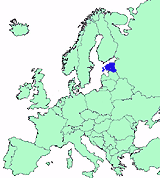was placed on the world map as well as on the European cultural area at the beginning of the thirteenth century when crusades reached what was then the pagan Eastern coast of the Baltic Sea. The Estonian territory was conquered and baptized and the main ruling class was made up of immigrants of mainly German descent. From this time on, the current territory of Estonia and Latvia was known as Livonia (Livland), and later also known as Old Livonia (Alt-Livland) in some areas that had been divided between the Danes, the Order and several bishoprics.
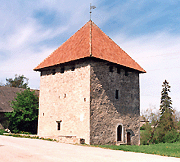 Crusaders brought along lime burning skills, previously not known here, which is why the appearance of the country changed considerably in the following centuries permanent and monumental stone buildings were constructed. At first the symbols of the new power were built from stone the churches, but quite soon the first stone strongholds also appeared. All four masters of the territory of Estonia in the Middle Ages the Kingdom of Denmark, Livonian Order and Saare-Lääne (Oesel-Wiek) and Tartu (Dorpat) Bishoprics built strongholds in the local restless areas during the Middle Ages.
Crusaders brought along lime burning skills, previously not known here, which is why the appearance of the country changed considerably in the following centuries permanent and monumental stone buildings were constructed. At first the symbols of the new power were built from stone the churches, but quite soon the first stone strongholds also appeared. All four masters of the territory of Estonia in the Middle Ages the Kingdom of Denmark, Livonian Order and Saare-Lääne (Oesel-Wiek) and Tartu (Dorpat) Bishoprics built strongholds in the local restless areas during the Middle Ages.
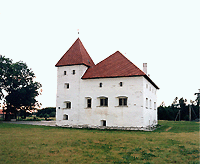 By the end of the Middle Ages, 30 larger stone strongholds had been built in Estonia.
By the end of the Middle Ages, 30 larger stone strongholds had been built in Estonia.
Both the Order and the bishoprics started to feudalize the lands to vassals of German blood in order to manage the conquered areas. This is how the first manors came into being. In addition, the Order, bishoprics and cloisters also established manors for their versatile business activities. By the end of the Middle Ages, approximately 500 manors had been established in Estonia. The overwhelming majority of them had been built as modest wooden buildings but in about a hundred manors fortress dwellings or
vassal strongholds
were constructed.
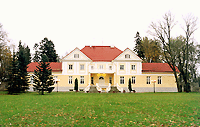 The Livonian War that took place in the middle of the 16th century left local strongholds in ruins, but at the same time, it boosted the development of manors. Side by side with the disappearance of the Order and bishoprics, the former vassals began to play an increasingly important role in the local state arrangement. Nobility associations known as knighthoods performed in Estonia (in the whole of Old Livonia) local government functions up until World War I. The so-called knight manor (in German: Rittergut) became the main
type of manors,
the owner of which had a number of status-related rights along with many stately responsibilities. The number of manors had grown to around a thousand by the 18th century.
The Livonian War that took place in the middle of the 16th century left local strongholds in ruins, but at the same time, it boosted the development of manors. Side by side with the disappearance of the Order and bishoprics, the former vassals began to play an increasingly important role in the local state arrangement. Nobility associations known as knighthoods performed in Estonia (in the whole of Old Livonia) local government functions up until World War I. The so-called knight manor (in German: Rittergut) became the main
type of manors,
the owner of which had a number of status-related rights along with many stately responsibilities. The number of manors had grown to around a thousand by the 18th century.
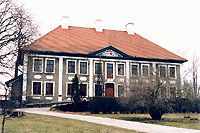 The heyday of manors and the nobility-based local authorities self-government of the nobility arrived in the 18th century. The Estonian territories conquered by Russians in the Northern War fought between Russia and Sweden in the 18th century were subjected to the Russian Crown on the condition that all former rights and privileges of the nobility remained the so-called special Baltic order. In fact, the rights of the nobility were even increased and in addition, the local nobility started to play an important role in the top power circles of The Russian Empire. This is how Old Livonia or the Baltic Provinces (the current territory of territory of present-day Estonia and Latvia) became one of the most developed regions in the Russian Empire, but at the same time, the oppression of peasants, mainly Estonians, increased too.
The heyday of manors and the nobility-based local authorities self-government of the nobility arrived in the 18th century. The Estonian territories conquered by Russians in the Northern War fought between Russia and Sweden in the 18th century were subjected to the Russian Crown on the condition that all former rights and privileges of the nobility remained the so-called special Baltic order. In fact, the rights of the nobility were even increased and in addition, the local nobility started to play an important role in the top power circles of The Russian Empire. This is how Old Livonia or the Baltic Provinces (the current territory of territory of present-day Estonia and Latvia) became one of the most developed regions in the Russian Empire, but at the same time, the oppression of peasants, mainly Estonians, increased too.
 The mass construction of imposing manor complexes began to a wide extent in the 1760s and lasted for over a century and a half until World War I. Everything that has been retained to this day, with a few exceptions, was built precisely at that time. In the 18th century and at the beginning of the 19th century, the main construction work was centered in northern Estonia, where a number of manors in the
Baroque
and
Classicist
styles were established. In the second half of the 19th century and at the beginning of the 20th century, construction also intensified in southern Estonia, leaving a number of
Historicist
and
Art Nouveau
(here called usually Jugend) manors.
The mass construction of imposing manor complexes began to a wide extent in the 1760s and lasted for over a century and a half until World War I. Everything that has been retained to this day, with a few exceptions, was built precisely at that time. In the 18th century and at the beginning of the 19th century, the main construction work was centered in northern Estonia, where a number of manors in the
Baroque
and
Classicist
styles were established. In the second half of the 19th century and at the beginning of the 20th century, construction also intensified in southern Estonia, leaving a number of
Historicist
and
Art Nouveau
(here called usually Jugend) manors.
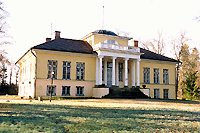 Impressive manor centers had been shaped as magnificent ensembles, where a palace-like main building was sometimes surrounded by parks of up to dozens of hectares in size with bowers, sculptures, bodies of water and bridges. In front of the main building there was usually a circuit, the so-called circle of honor next to which the most important outbuildings of the manor were usually situated the granary barn and stable-coach house. The rest of the buildings were located in close proximity. Behind the main building there was usually a park.
Impressive manor centers had been shaped as magnificent ensembles, where a palace-like main building was sometimes surrounded by parks of up to dozens of hectares in size with bowers, sculptures, bodies of water and bridges. In front of the main building there was usually a circuit, the so-called circle of honor next to which the most important outbuildings of the manor were usually situated the granary barn and stable-coach house. The rest of the buildings were located in close proximity. Behind the main building there was usually a park.
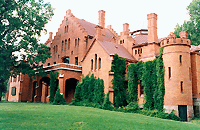 Both the
park and the complex
of business buildings were usually surrounded by a fence. Often the fence was bordered by a stone wall boasting artistic gates and sometimes even gate towers. The dryer and smithy were considered to be inflammable buildings and were usually situated further away. The roads going to manors were usually made as straight as arrows and designed as avenues. In bigger and more impressive manors all buildings and their details had usually been included in an integral ensemble. But modest and smaller manor centers were also often stylish complexes where the location and proportions of buildings had been carefully chosen and harmoniously melted into their natural surroundings.
Both the
park and the complex
of business buildings were usually surrounded by a fence. Often the fence was bordered by a stone wall boasting artistic gates and sometimes even gate towers. The dryer and smithy were considered to be inflammable buildings and were usually situated further away. The roads going to manors were usually made as straight as arrows and designed as avenues. In bigger and more impressive manors all buildings and their details had usually been included in an integral ensemble. But modest and smaller manor centers were also often stylish complexes where the location and proportions of buildings had been carefully chosen and harmoniously melted into their natural surroundings.
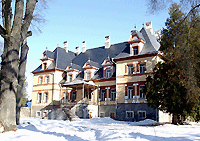 Around 1910, there were 1245 manors on the territory of Estonia, not including manor dairy farms (separate building complexes or departments of main manors, in German: Hoflage) and pastorates. Of these 1026 were knight manors (rittergut). There were also 122 state manors, 69 semi-manors (a manor without privileges and rights, in German: landstelle), 17 town manors and 11 manors belonging to knighthoods. If we add to the latter 108 pastorates and around 600 separate building complexes of main manors, or manor dairy farms, we will get around two thousand different manor centers.
Around 1910, there were 1245 manors on the territory of Estonia, not including manor dairy farms (separate building complexes or departments of main manors, in German: Hoflage) and pastorates. Of these 1026 were knight manors (rittergut). There were also 122 state manors, 69 semi-manors (a manor without privileges and rights, in German: landstelle), 17 town manors and 11 manors belonging to knighthoods. If we add to the latter 108 pastorates and around 600 separate building complexes of main manors, or manor dairy farms, we will get around two thousand different manor centers.
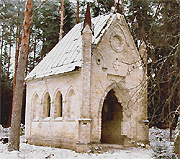 The manors received the first blow in 1905, when during the revolution that had emerged in Russia, the rebels burned down over a hundred manors. What was even more devastating than the material destruction was the breakdown of relations and traditions. The year 1905 was the final straw and spoiled the relations between the Estonian peasantry and the elite of the Baltic German nobility that had already been rather complicated and tangled for awhile. When World War I ended the former state arrangement of Old Livonia, the Estonians established their independent nation-state on its ruins in 1918, where they did not see a noteworthy place for manors or the Baltic nobility. The Land Reform carried out in 1919 ended the era of the manor by alienating all knight manors from their owners. The alienated lands including the manor centers that had been designed as architecturally integral were divided up into small peasant holdings.
The manors received the first blow in 1905, when during the revolution that had emerged in Russia, the rebels burned down over a hundred manors. What was even more devastating than the material destruction was the breakdown of relations and traditions. The year 1905 was the final straw and spoiled the relations between the Estonian peasantry and the elite of the Baltic German nobility that had already been rather complicated and tangled for awhile. When World War I ended the former state arrangement of Old Livonia, the Estonians established their independent nation-state on its ruins in 1918, where they did not see a noteworthy place for manors or the Baltic nobility. The Land Reform carried out in 1919 ended the era of the manor by alienating all knight manors from their owners. The alienated lands including the manor centers that had been designed as architecturally integral were divided up into small peasant holdings.
This was followed by a rapid downfall of manor complexes schools, orphanages, community centers, and so on, were placed only in a few, better and more suitable manor houses. A number of manor houses, however, remained without a specific purpose and started to gradually become dilapidated. The last connection between manors and their historic owners was cut in 1939, when all Baltic Germans who were still living in Estonia including the former manor owners of the nobility relocated to Germany during the Umsiedlung in the course of World War II, which had just begun.
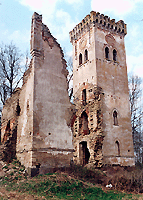 The Soviet rule that began in the 1940s empowered the destruction of manors even further the Baltic nobility were then considered the bloodsuckers of the peasantry, which is why neither their spiritual heritage nor the buildings constructed by them were appreciated. Manor houses were then appreciated only with regard to their practical value only those that had a function and were used as the centers of collective farms, schools, apartments or were in sufficiently good shape to be used in some other way remained. The rest perished gradually, i.e. became dilapidated and were torn down.
The Soviet rule that began in the 1940s empowered the destruction of manors even further the Baltic nobility were then considered the bloodsuckers of the peasantry, which is why neither their spiritual heritage nor the buildings constructed by them were appreciated. Manor houses were then appreciated only with regard to their practical value only those that had a function and were used as the centers of collective farms, schools, apartments or were in sufficiently good shape to be used in some other way remained. The rest perished gradually, i.e. became dilapidated and were torn down.
Only in the 1960-70s, and despite the official policy, manors came to be appreciated here and there with the support of local enthusiasts and more valuable houses also began to be renovated. In the 1980s, the ideological roadblocks were also gradually removed from this road. In the Republic of Estonia, which regained its independence in 1991, the German-originated nobility and the manors built by them are not regarded only negatively, as was the case in the intermediary seven decades. It is acknowledged as an important part of Estonian history and the carrier of occidental cultural values, thanks to which Estonia has been a part of Europe for more than seven centuries.
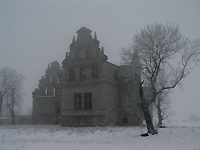 However, the long decades in the meantime have performed their inevitable chores. At the beginning of 2005, there were 414 manor houses (not including pastorates and manor dairy farms) in Estonia, according to the data gathered by the author. These manor houses had more or less retained their original form and had not been reconstructed, i.e. a scanty third of the overall figure. Additionally, there are about two hundreds of manors lying in ruins or being completely rebuilt. The rest have been destroyed.
However, the long decades in the meantime have performed their inevitable chores. At the beginning of 2005, there were 414 manor houses (not including pastorates and manor dairy farms) in Estonia, according to the data gathered by the author. These manor houses had more or less retained their original form and had not been reconstructed, i.e. a scanty third of the overall figure. Additionally, there are about two hundreds of manors lying in ruins or being completely rebuilt. The rest have been destroyed.
Luckily, about a hundred manors that have been preserved are in excellent shape and have found a suitable purpose. They can be exhibited with a feeling of pride as Estonian symbols reflecting our long, glorious history.






